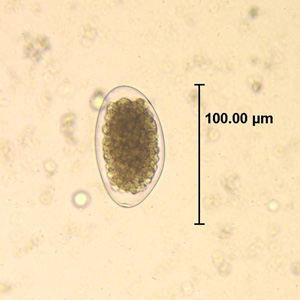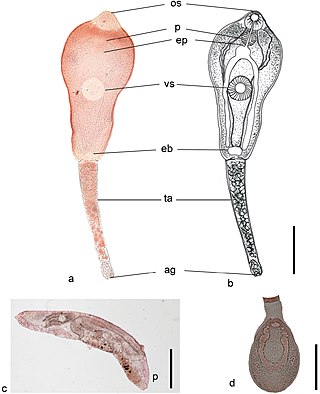
Digenea is a class of trematodes in the Platyhelminthes phylum, consisting of parasitic flatworms with a syncytial tegument and, usually, two suckers, one ventral and one oral. Adults commonly live within the digestive tract, but occur throughout the organ systems of all classes of vertebrates. Once thought to be related to the Monogenea, it is now recognised that they are closest to the Aspidogastrea and that the Monogenea are more closely allied with the Cestoda. Around 6,000 species have been described to date.

Dicrocoelium dendriticum, the lancet liver fluke, is a parasite fluke that tends to live in cattle or other grazing mammals.

Lymnaea stagnalis, better known as the great pond snail, is a species of large air-breathing freshwater snail, an aquatic pulmonate gastropod mollusk in the family Lymnaeidae. The great pond snail is a model organism to study parasitology, neurology, embryonal development and genetic regulation.

Plagiorchiida is a large order of trematodes, synonymous to Echinostomida. They belong to the Digenea, a large subclass of flukes. This order contains relatively few significant parasites of humans.

Echinostomata is a suborder of the parasitic flatworm order Plagiorchiida. The suborder contains numerous species that are parasitic in humans.

Psilostomatidae is a family of trematodes in the order Plagiorchiida. They parasitise aquatic vertebrates as definitive hosts.

Trichostrongylus species are nematodes, which are ubiquitous among herbivores worldwide, including cattle, sheep, donkeys, goats, deer, and rabbits. At least 10 Trichostrongylus species have been associated with human infections. Infections occur via ingestion of infective larvae from contaminated vegetables or water. Epidemiological studies indicate a worldwide distribution of Trichostrongylus infections in humans, with the highest prevalence rates observed in individuals from regions with poor sanitary conditions, in rural areas, or who are farmers / herders. Human infections are most prevalent in the Middle East and Asia, with a worldwide estimated prevalence of 5.5 million people.

Opisthorchiidae is a family of digenean trematodes. Opisthorchiidae have cosmopolitan distribution.

Heterophyidae is a family of intestinal trematodes in the order Plagiorchiida.

Haplorchis taichui is a species of intestinal fluke in the family Heterophyidae. It is a human parasite.
Gorgodera amplicava is a species of digenetic trematodes whose definitive hosts include amphibians. Its first intermediate host includes the fingernail clam, which is followed by a second intermediate host, which can be a snail, tadpole, or crayfish. Gorgodera is a distome, meaning its body includes two suckers, one oral and one ventral.
Telorchiidae is a family of trematode parasites.
Metorchis is a genus of flatworms belonging to the family Opisthorchiidae.

Echinostomatidae is a family of trematodes in the order Plagiorchiida, first described in 1899.
Gorgoderidae is a family of trematodes in the order Plagiorchiida.
Prosthenorchis is a genus of parasitic worms belonging to the family Oligacanthorhynchidae. Prosthenorchis have a trunk up to 50 mm long, a proboscis that is not ornate with three barbed hooks in each of 12 rows. They have complex hook roots with large manubria, and a small discoid posterior hook base. There are up to 23 festoons. Gonopore is subterminal. The primary host are primates in South America and Felidae in Africa with cockroaches and beetles as intermediate hosts.
Derogenidae is a family of trematodes belonging to the order Plagiorchiida.

Philophthalmus is a genus of trematodes belonging to the family Philophthalmidae.
Gorgodera is a genus of flatworms belonging to the family Gorgoderidae.

Echinostomatinae is a subfamily of trematodes in the order Plagiorchiida, first described in 1899.











